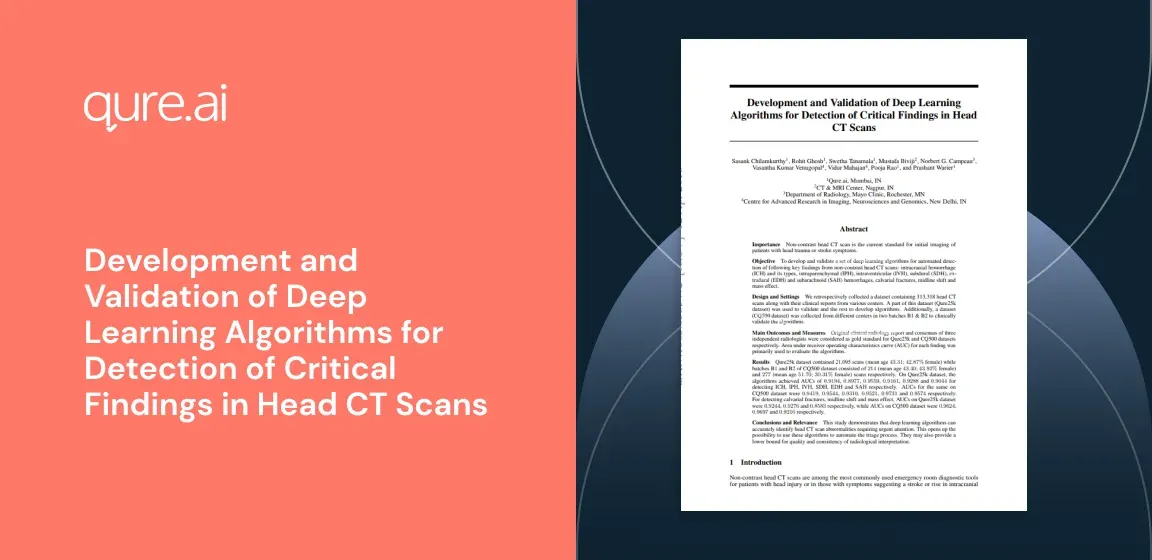Importance
Published 12 Mar 2018
Development and Validation of Deep Learning Algorithms for Detection of Critical Findings in Head CT Scans
Author: Sasank Chilamkurthy 1, Rohit Ghosh 1, Swetha Tanamala 1, Mustafa Biviji 2, Norbert G. Campeau 3, Vasantha Kumar Venugopal 4, Vidur Mahajan 4, Pooja Rao 1, Prashant Warier 11

Back
Non-contrast head CT scan is the current standard for initial imaging of patients with head trauma or stroke symptoms.
Objective
To develop and validate a set of deep learning algorithms for automated detection of following key findings from non-contrast head CT scans: intracranial hemorrhage (ICH) and its types, intraparenchymal (IPH), intraventricular (IVH), subdural (SDH), ex- tradural (EDH) and subarachnoid (SAH) hemorrhages, calvarial fractures, midline shift and mass effect.
Design And Settings
We retrospectively collected a dataset containing 313,318 head CT scans along with their clinical reports from various centers. A part of this dataset (Qure25k dataset) was used to validate and the rest to develop algorithms. Additionally, a dataset (CQ500 dataset) was collected from different centers in two batches B1 & B2 to clinically validate the algorithms.
Main Outcomes And Measures
Original clinical radiology report and consensus of three independent radiologists were considered as gold standard for Qure25k and CQ500 datasets respectively. Area under receiver operating characteristics curve (AUC) for each finding was primarily used to evaluate the algorithms.
Results
Qure25k dataset contained 21,095 scans (mean age 43.31; 42.87% female) while batches B1 and B2 of CQ500 dataset consisted of 214 (mean age 43.40; 43.92% female) and 277 (mean age 51.70; 30.31% female) scans respectively. On Qure25k dataset, the algorithms achieved AUCs of 0.9194, 0.8977, 0.9559, 0.9161, 0.9288 and 0.9044 for detecting ICH, IPH, IVH, SDH, EDH and SAH respectively. AUCs for the same on CQ500 dataset were 0.9419, 0.9544, 0.9310, 0.9521, 0.9731 and 0.9574 respectively. For detecting calvarial fractures, midline shift and mass effect, AUCs on Qure25k dataset were 0.9244, 0.9276 and 0.8583 respectively, while AUCs on CQ500 dataset were 0.9624, 0.9697 and 0.9216 respectively.
Conclusions And Relevance
This study demonstrates that deep learning algorithms can accurately identify head CT scan abnormalities requiring urgent attention. This opens up the possibility to use these algorithms to automate the triage process. They may also provide a lower bound for quality and consistency of radiological interpretation.
Authors
Sasank Chilamkurthy 1, Rohit Ghosh 1, Swetha Tanamala 1, Mustafa Biviji 2, Norbert G. Campeau 3, Vasantha Kumar Venugopal 4, Vidur Mahajan 4, Pooja Rao 1, Prashant Warier 11
Citation
1. Qure.ai 2. Mumbai 3. CT and MRI center 4. Nagpur 5. Department of Radiology 6. Mayo Clinic 7. Rochester 8. MN 9. Centre for Advanced Research in Imaging 10. Neurosciences and Genomics 11. New Delhi